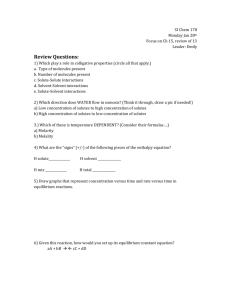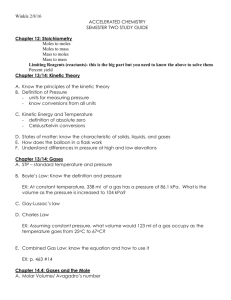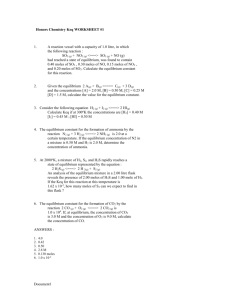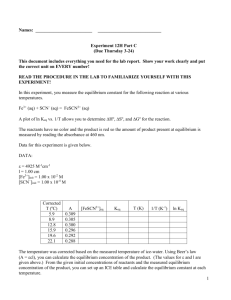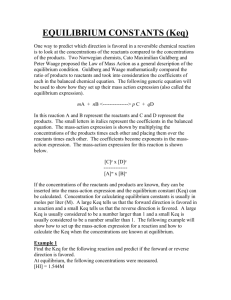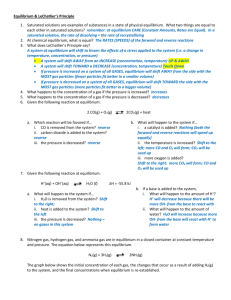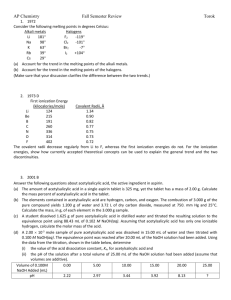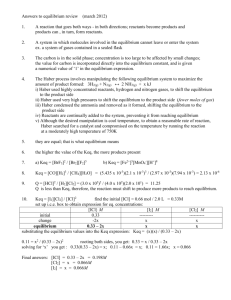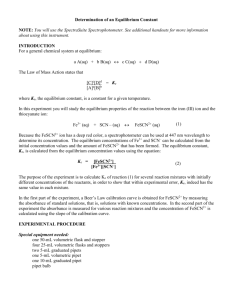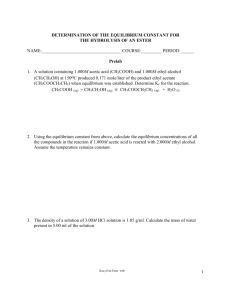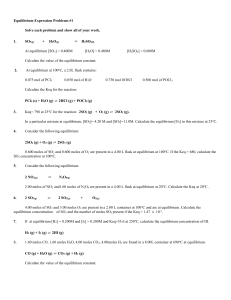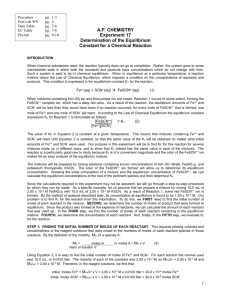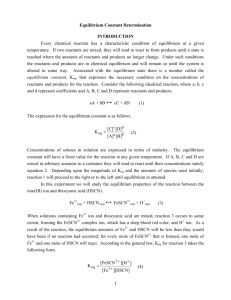Study Guide for Exam II Spring 2013 A list of some of the topics we
advertisement
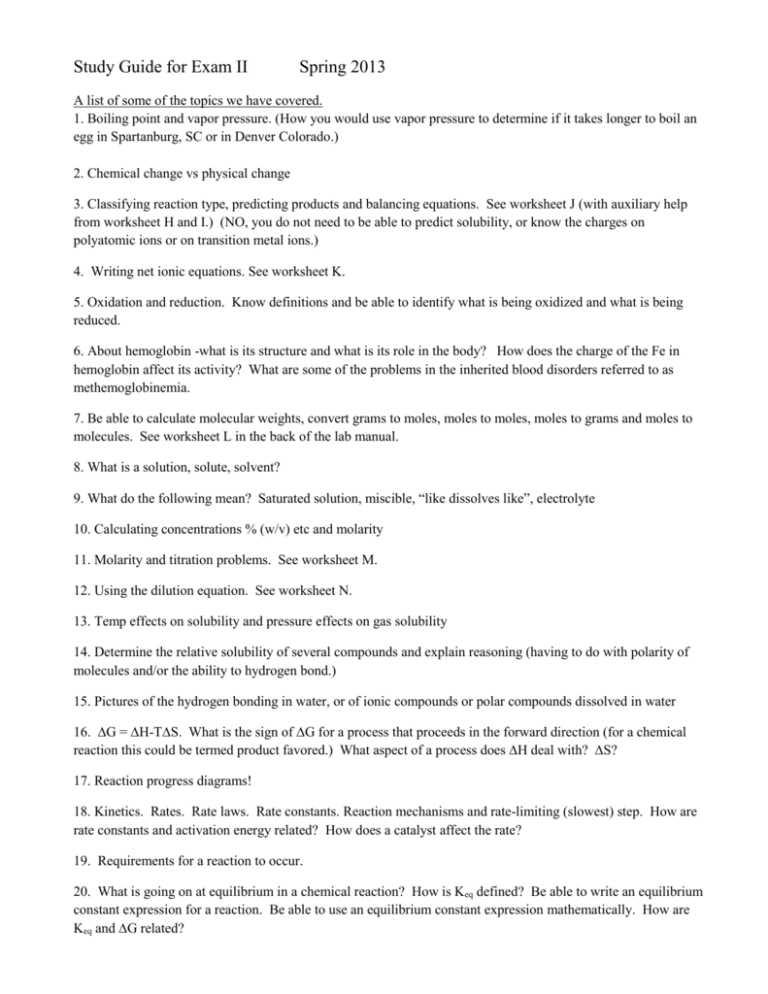
Study Guide for Exam II Spring 2013 A list of some of the topics we have covered. 1. Boiling point and vapor pressure. (How you would use vapor pressure to determine if it takes longer to boil an egg in Spartanburg, SC or in Denver Colorado.) 2. Chemical change vs physical change 3. Classifying reaction type, predicting products and balancing equations. See worksheet J (with auxiliary help from worksheet H and I.) (NO, you do not need to be able to predict solubility, or know the charges on polyatomic ions or on transition metal ions.) 4. Writing net ionic equations. See worksheet K. 5. Oxidation and reduction. Know definitions and be able to identify what is being oxidized and what is being reduced. 6. About hemoglobin -what is its structure and what is its role in the body? How does the charge of the Fe in hemoglobin affect its activity? What are some of the problems in the inherited blood disorders referred to as methemoglobinemia. 7. Be able to calculate molecular weights, convert grams to moles, moles to moles, moles to grams and moles to molecules. See worksheet L in the back of the lab manual. 8. What is a solution, solute, solvent? 9. What do the following mean? Saturated solution, miscible, “like dissolves like”, electrolyte 10. Calculating concentrations % (w/v) etc and molarity 11. Molarity and titration problems. See worksheet M. 12. Using the dilution equation. See worksheet N. 13. Temp effects on solubility and pressure effects on gas solubility 14. Determine the relative solubility of several compounds and explain reasoning (having to do with polarity of molecules and/or the ability to hydrogen bond.) 15. Pictures of the hydrogen bonding in water, or of ionic compounds or polar compounds dissolved in water 16. ∆G = ∆H-T∆S. What is the sign of ∆G for a process that proceeds in the forward direction (for a chemical reaction this could be termed product favored.) What aspect of a process does ∆H deal with? ∆S? 17. Reaction progress diagrams! 18. Kinetics. Rates. Rate laws. Rate constants. Reaction mechanisms and rate-limiting (slowest) step. How are rate constants and activation energy related? How does a catalyst affect the rate? 19. Requirements for a reaction to occur. 20. What is going on at equilibrium in a chemical reaction? How is Keq defined? Be able to write an equilibrium constant expression for a reaction. Be able to use an equilibrium constant expression mathematically. How are Keq and ∆G related? Instructions Show logic and calculations for all problems. Remember to include units and be careful with sig. fig.. You will be given a periodic table, electronegativity table, the charges on some polyatomic ions and transition metal ions, and the following supplementary information. Equations for temperature: F = 1.8 C + 32 K = C + 273.15 English to metric conversions Length 1 m = 39.47 in Mass 1 kg = 2.205 lb Volume 1 L = 1.057 qt 1 in = 2.54 cm 1 lb = 453.5 g R = 0.08205 (LatmmolK) 1 atm = 760. 0 mm Hg 1. Determine the type of reaction (like single replacement), predict the products of the following reactions & balance the equations. Type a) FeCl3 + K → b) K3PO4(aq) + c) Ca + d) HCl(aq) + e) C5H12 f) K + H2O CoCl2(aq) → O2 → + NaOH(s) → O2 → 2. Write a net-ionic equation for the following full balanced equations: a) MgCl2(aq) + K2CO3(aq) → MgCO3(s) + 2 KCl(aq) b) 2Cs(s) + CaBr2(aq) → Ca(s) + 2CsBr(aq) 3. a) How many moles of propane (C3H8) are present in 500.8 g propane? b) How many propane molecules are present in this 500.8 g? c) How many C atoms are present in this sample? 4. How many anions are in 0.0135 moles of MgBr2? 5. Calculate the formula weight (molecular weight) of Ca(NO3)2. 6. Given the following reaction between nitrogen and oxygen to form nitric oxide: N2(g) + O2 (g) 2 NO(g) How many grams of NO are obtained when 8.6 g of N2 are completely reacted? 7. Magnesium metal reacts with iron (II) chloride according to the equation Mg(s) + FeCl2(aq) MgCl2(aq) + Fe(s). Is the magnesium oxidized or reduced? Is the iron (II) ion oxidized or reduced? 8. Define reduction. K2 Cr2 O7 9. In the following reaction CH2CH2OH + O2 → do you know? CH2CH2O, is CH2CH2OH oxidized or reduced? How 10. Briefly describe a human genetic disease based on oxidation-reduction chemistry of hemoglobin. A full credit answer should include one or more equations for chemical reactions. 11. A sample of 235.00 g of Mg reacts completely with HCl(aq) to produce an explosive gas and an ionic compound. a) Write a balanced chemical equation for the reaction. b) How many grams of gaseous product are produced? 12. For the following oxidation-reduction reaction: Ca + Fe3+ Ca2+ + Fe a) Write the half-reactions for this reaction. b) Which reactant is being oxidized (How do you know?) and which is being reduced? 13. What is the concentration in molarity units of a solution that has 7.00 g of NaCl dissolved in water to give 520.6 mL of solution? 14. If 83.00 mL of a 3.075 M solution of NaOH is diluted to a final volume of 12.88 L, what will its concentration be? 15. Based on the following reaction, HCl + NaOH H2O + NaCl, determine the concentration of hydrochloric acid, HCl, if 10.00 mL of acid required 15.51 mL of 0.2500 M NaOH to reach the endpoint of the titration. 16. What volume of a 15% (w/v) solution of LiOH would be produced if you used 8750 g of LiOH? 17. Which of the following compounds would you predict to have the highest, intermediate, and lowest solubility in water? Explain your answer, using structures where appropriate. H H H H a. C C H C C O b. H H H H H H H C H O H c. C H H H C C H H H C H H 18. The following mechanism has been proposed: k1 Step 1 O3 O2 + O k2 Step 2 O + O3 2 O2 a) Write a balanced equation for the overall reaction. b) Write the predicted rate law for the overall reaction if k2 is much larger than k1. c) Identify any reaction intermediates. 19. Given these data for the reaction of Fe3+ with I- : 2 Fe3+ (aq) + 2 I- (aq) 2 Fe2+ (aq) + I2 (aq) Exp# 1 2 3 3+ [Fe ] (M) 0.0400 0.0800 0.0400 - [I ] (M) 0.0300 0.0300 0.0600 Initial rate (M/s) 8.10 x 10-4 1.62 x 10-3 3.24 x 10-3 Be sure to explain the logic for your answers. a) Write a general rate law for the reaction. b) Use the initial rate data to write the specific rate law consistent with the data. Make sure you solve to obtain a numerical value for k. c) Write a chemical rxn. for the reactant side of the rate limiting step in the rxn. mechanism. d) What is the initial rate of the rxn. with 0.090 M Fe3+ and 0.50 M I-? e) If I told you that the value of k that you obtained is relatively large, what height hill would you draw for this reaction on a reaction progress diagram (vertical axis = G°). 20. Explain how/why changes in temperature result in changes in a rate constant, k. Include an appropriate graph. 21. Write equilibrium constant expressions for the following reactions: a) 2 H2 (g) + 2 NO (g) 2 H2O (g) + N2 (g) b) Fe (s) + CO2 (g) FeO (s) + CO (g) 22. Shown below is a balanced equation for the decomposition of H2S to form H2 and S2. 2 H2S (g) 2 H2 (g) + S2 (g) a) Write an equilibrium constant expression for the reaction. b) Given the equilibrium concentrations: [H2S] = 0.1007 M, [H2] = 0.0219 M, and [S2] = 3.30 × 10-3 M, calculate the numerical value of Keq. c) Assume the equilibrium is perturbed. When equilibrium is reestablished, the following concentrations are observed: [H2] = 0.00287 M and [S2] = 0.171 M. Calculate [H2S] under these new conditions. d) What can you say about the forward and reverse reaction rates when the system is at equilibrium? e) How is Keq defined? (I am not asking you to write an equilibrium constant expression using concentrations.) 23. a) Qualitatively, for the reaction shown #6, would the ∆G° value be positive or negative? Explain your logic. b) Assuming I told you the reaction in #6, was relatively fast. Draw a reaction coordinate diagram that describes that system. Then draw another showing how the system would be changed in the presence of a catalyst. Be sure to clearly label all important quantities.
